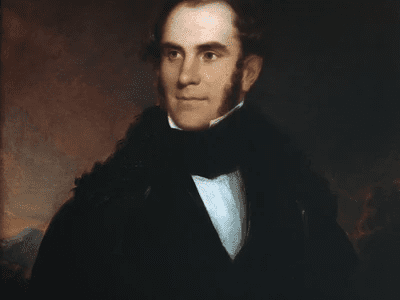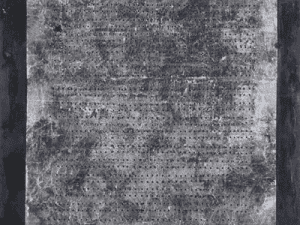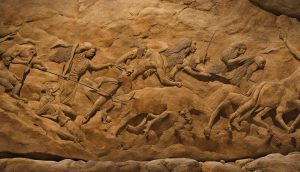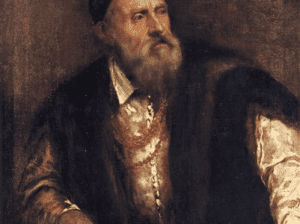(Skip to bullet points (best for students))

Born: 1801
Died: 1848
Summary of Thomas Cole
Thomas Cole’s paintings, like Ralph Waldo Emerson’s essays, are monuments to the hopes and concerns of the emerging American country in the mid-nineteenth century, as well as ecstatic celebrations of its natural settings. Cole was born in the industrial north-west of England and immigrated to the United States as a young man, where he attempted to portray the majestic beauty of the American wilderness in paint. He is regarded as the first artist to apply a European Romantic landscape painter’s eye to those settings, as well as a person whose idealism and religious sensitivities reflected a distinctly American ethos.
Indeed, his work continues to reverberate as an instance of that attitude in the current day, despite his upbringing in Britain – or maybe because of that background, which offered him a fresh viewpoint.
No one has ever attempted to apply the motifs and methods of European Romantic landscape painting to the landscapes of North America until Thomas Cole. The dramatic magnificence of Caspar David Freidrich or J.M.W Turner has been transferred onto the Catskill and Adirondack Mountains in his paintings. However, unlike younger American painters like Albert Bierstadt, who had direct touch with The Düsseldorf School of painting and therefore with the tradition in which they found themselves, Cole was primarily self-taught, and so represents the quintessential American image of the autodidact.
Thomas Cole is regarded as the founder of the Hudson River School, a group of American painters who tried to capture the unspoiled magnificence of the American environment, notably that of New York State’s Hudson River Valley. From the mid-1820s onwards, Cole was the first to investigate this region, taking steamboat journeys up the valley, and his work became a touchstone for a generation of American painters, including Frederic Edwin Church, Albert Bierstadt, and Asher Brown Durand.
Cole’s painting encapsulates all of the paradoxes of European settler culture in America in many ways. He was enamoured with the magnificent wildness of the American environment and tried to protect it via his work, yet his very presence in it, as well as the trajectory of his career, were dependent on the urbanisation and civilization that endangered it. Cole’s Eurocentric gaze on seemingly empty wildernesses that had been populated for centuries is also troubling from a modern perspective; where Native Americans do appear in his work, such as in Falls of the Kaaterskill (1826), it is as picturesque flecks rather than characterised participants in the scene.
Cole’s paintings frequently act as warnings about human civilization’s fatal trajectory, foreshadowing the destruction of the natural environment and the unending development of industry, which the American project seemed to symbolise. Cole, a highly devout man, regarded these processes as infringing on God’s plan in some manner, and several of his writings suggest that a time of judgement or disaster is approaching.
Childhood
Thomas Cole was the only boy of the eight children born to Mary and James Cole in Bolton-le-Moors. During Thomas’s upbringing, his father, a woollen maker, relocated the family around a lot in pursuit of better jobs. This nomadic existence afforded the young artist a variety of possibilities, including a fourteen-year apprenticeship in a printshop in Chorley, where he learnt how to engrave designs for calico textiles, and a spell of employment as an engraver in Liverpool in 1817. Cole grew up with a passion for nature, and he and his sister Sarah would often go on walks in the north of England to appreciate the scenery.
Early Life
Cole acquired an early interest in North America as a result of his reading, which would come in handy when the family moved there in 1818. While his family relocated to Ohio, Thomas stayed in Philadelphia as a teenager and worked as a textile designer. It was in Philadelphia that he obtained an early contract to engrave images for a new version of the seventeenth-century puritan John Bunyan’s book Holy War (1682). Cole returned to Ohio in 1819 after a brief journey to the West Indies to be closer to his family and to assist his father with their wallpaper business. For the first time, he studied painting and was commissioned to produce several paintings
Cole returned to Philadelphia in 1823, where he studied at the Pennsylvania Academy of the Fine Arts. He came to New York two years later, eager to begin a professional creative career; once situated in the city, he began taking travels down the Hudson River Valley to paint the American wilderness. The young artist felt an instant connection to the scenery of the area, which he would carry with him for the rest of his life. From this moment forward, his art became the touchstone for the Hudson River School, a Romantic landscape painting style. In a poem titled “The Wild” written in 1825, he expresses his own goals for the project:
‘Friends of my heart, lovers of nature’s works,
Let me transport you to those wild, blue mountains
That rear their summits near the Hudson’s wave’
He believed that his representations of the Catskills’ “blue mountains” would give his viewers “a sweet foretaste of heaven” But Cole was well aware of the dangers that this idyllic setting posed: even on his earliest travels up the Hudson, he would have come across indications of activity – sawmills, tanneries, burned-over farms – among the beauty.
Mid Life
Cole’s career took off in 1825 when he sold works to Asher Brown Durand and John Trumbull, two of the most well-known artists of the day, as well as William Dunlap, an eminent writer and historian. Cole was elected to the National Academy of Design the following year, and he frequently showed there.
Cole’s cultural foundation was European, as it was for all white American painters at the time, and he felt compelled to study the great masters of the Classical and Renaissance eras in order to improve his craft. So, in the summer of 1829, he embarked on a lengthy journey of Europe, stopping briefly at the Niagara Falls. “As the artist put it,” he said “I can’t imagine visiting Europe without seeing them. I’d like to take ‘one final lingering glance’ at our beautiful surroundings. I’ll try to imprint its characteristics so deeply in my mind that even when I’m surrounded by gorgeous landscape from other nations, I won’t forget about them.”
Cole’s reputation as a landscape painter had already established itself in his adoptive nation by the time of his journey, to the point that his friend, William Cullen Bryant, composed a poem in his honour immediately before his departure, titled “To Cole, The Painter, Departing for Europe” The author asks the artist not to overlook the New World’s beauty among the glories of European art history.
Cole gained a lot from his European trip, and he was able to meet English Romantic landscape artists John Constable and J M. W. Turner, as well as portraitist Thomas Lawrence; art historian Matthew Baigell claims that Turner’s cityscapes inspired Cole’s Course of Empire series composition. While overseas, he also participated in a number of exhibits. While he was regarded as a pioneering artist in America, he was hesitant to accept some of the more radical stylistic advances seen in his British contemporaries’ work, particularly Turner’s, whom he believed put too much attention on colour and light effects.
Cole’s return from Europe in November 1832 signalled the beginning of a pivotal period in both his artistic and personal lives. In 1833, he met his future patron Luman Reed, for whom he began work on The Course of the Empire, a famous series of paintings (1836). In the same year, he married Maria Bartow, the niece of the farm owner from whom Cole rented a studio in Catskill, New York, while working on the series. Cole found inspiration in the surrounding surroundings, so the pair decided to make Catskill their permanent home.
He wrote his influential “Essay on American Scenery” there in 1835, in which he considers the encroaching threat of industrial development to the natural world: “there are those who regret that with the improvements of cultivation the sublimity of the wilderness should pass away: for those scenes of solitude from which the hand of nature has been lifted, affect the mind with a more deep toned emotion than aught which the hand of man has touched.”
Late Life
Thomas Cole’s later years were marked by introspection and recurrent sorrow. He was greatly disturbed by the inexorable march of urbanisation and industrialization, which he saw as threatening the American wilderness; he is believed to have loathed towns, seeing “a presentiment of evil in them” as Matthew Baigell puts it. Meanwhile, while Cole’s paintings continued to show landscapes, they increasingly seemed to become vehicles for him to address topics such as time and history, as seen in his Voyage of Life (1842) series.
Cole was also suffering from bad health at the time, so in the summer of 1841, he decided to return to Europe. When he returned to New York a year later, he joined the Episcopal Church, and religion became an increasingly important part of his life from then on. “Art, in its true sense, is, in fact, man’s lowly imitation of the creative power of the Almighty.” he said of spirituality’s effect on art. He agreed to take Frederic Edwin Church on as a student in 1844. This was a fortunate choice, as Cole would have a significant impact on the young artist’s work, ensuring the Hudson River School’s and, in particular, Cole’s painting’s legacy.
Cole returned to the Niagara Falls in the summer of 1847, maybe yearning for a sight of pure nature once more. This would be his final big journey; he died in February of the following year at the age of 47. “the paintings of Cole are of that nature that it hardly transcends the proper use of language to call them acts of religion.” said Cole’s friend and novelist William Cullen Bryant in a eulogy delivered at the artist’s death.
Famous Art by Thomas Cole
Lake with Dead Trees (Catskill)
1825

One of Cole’s first paintings, Lake with Dead Trees, depicts the landscapes of the Catskill Mountains in southeast New York State. Two deer are stirred into action at the edge of a still lake, surrounded by dead trees: one is poised and attentive, the other jumps skittishly to the right. The sun shines through a gloomy sky behind the dark forested peaks.
This painting, one of five on Cole’s return from his first major trip along the Hudson Valley, was interpreted as a meditation on the nature of life, death, and the passage of time. It was one of five paintings exhibited in New York City in November 1825 on Cole’s return from his first major trip along the Hudson Valley.
The Consummation of Empire
1836

The Consummation of Empire is one of five paintings commissioned by Cole’s patron Luman Reed between 1833 and 1836 and titled The Course of Empire. Each painting in the series portrays the same terrain at a different period of an imagined civilization’s growth and demise. This, the series’ middle picture, depicts that civilization’s seeming victory, a landscape filled with classical porticos, rotundas, and sculpture, with a cheerful, colourful parade of residents going over the central bridge. To the right, a statue of Minerva, the goddess of knowledge, stands unnoticed by the throngs below.
The Pic-Nic
1846

Set in a wooded glade, this artwork shows an ideal scene of outdoor leisure activity. A group of individuals sits to the left, listening to a man play the guitar. Other, smaller groups of individuals appear to have split off from the main gathering and are eating and conversing on blankets. A boat is being rowed to the beach on the lake in the backdrop.
This painting, one of several by Cole made during his later years, depicts a completely different side of the American environment than the bleak wildernesses he studied early in his career: the untamed landscape has been tamed and transformed into a picnic spot.
BULLET POINTED (SUMMARISED)
Best for Students and a Huge Time Saver
- Thomas Cole’s paintings, like Ralph Waldo Emerson’s essays, are monuments to the hopes and concerns of the emerging American country in the mid-nineteenth century, as well as ecstatic celebrations of its natural settings.
- Cole was born in the industrial north-west of England and immigrated to the United States as a young man, where he attempted to portray the majestic beauty of the American wilderness in paint.
- He is regarded as the first artist to apply a European Romantic landscape painter’s eye to those settings, as well as a person whose idealism and religious sensitivities reflected a distinctly American ethos.
- No one has ever attempted to apply the motifs and methods of European Romantic landscape painting to the landscapes of North America until Thomas Cole.
- The dramatic magnificence of Caspar David Freidrich or J.M.W Turner has been transferred onto the Catskill and Adirondack Mountains in his paintings.
- Thomas Cole is regarded as the founder of the Hudson River School, a group of American painters who tried to capture the unspoiled magnificence of the American environment, notably that of New York State’s Hudson River Valley.
- From the mid-1820s onwards, Cole was the first to investigate this region, taking steamboat journeys up the valley, and his work became a touchstone for a generation of American painters, including Frederic Edwin Church, Albert Bierstadt, and Asher Brown Durand.
- Cole’s Eurocentric gaze on seemingly empty wildernesses that had been populated for centuries is also troubling from a modern perspective; where Native Americans do appear in his work, such as in Falls of the Kaaterskill (1826), it is as picturesque flecks rather than characterised participants in the scene.
- Cole’s paintings frequently act as warnings about human civilization’s fatal trajectory, foreshadowing the destruction of the natural environment and the unending development of industry, which the American project seemed to symbolise.
- Cole, a highly devout man, regarded these processes as infringing on God’s plan in some manner, and several of his writings suggest that a time of judgement or disaster is approaching.
Information Citations
En.wikipedia.org, https://en.wikipedia.org/.
Recommend0 recommendationsPublished in Artists







Responses